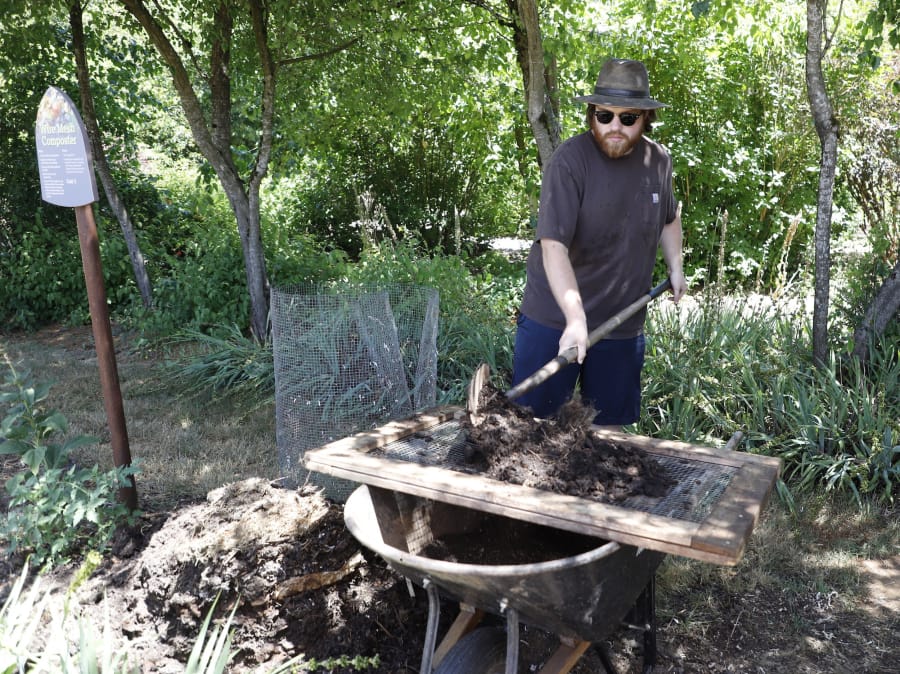BRUSH PRAIRIE — Nestled amid live music, organic honey samples and artisan booths Sunday at the Art in the Garden event, guests sought answers to their most pressing gardening question: Why does my compost stink?
That, along with questions about what to put in the pile and how to make it productive, is probably the most common question that Master Composter/Recycler Program volunteers field, said Barbara Rider, one such volunteer.
The volunteers organize through the county health department. On Sunday, they set up a composting demonstration and open house at one end of the NatureScaping of Southwest Washington gardens on the Center for Agriculture, Science and Environmental Education campus.
They had several compost-making systems on display, with volunteers to help the curious identify the pros and cons of each style, and to offer tips.
“Events like this are more to get people excited about it,” Rider said. “Answer questions for people who haven’t composted before and point them to books, or a lot of our free classes that we offer.”
Smelly compost piles are usually symptoms of a too-wet pile, or a pile too filled with greener, fresher material. The tricks are in finding the right ratios of waste matter and keeping it aerated, Rider explained.
“What you’re trying to do is, you’re trying to feed bacteria. That’s what really does 99 percent of the work in a compost bin,” she said. “You’re just basically making it a perfect environment for them to break it down into rich, crumbly soil.”
Generally, a pile has to be about a cubic yard in size to work properly. Piles smaller than that will take longer to produce viable compost, if they do at all.
The next piece is moisture, and keeping the pile wet enough.
“You don’t want it to be too wet, because then it’ll kinda drown out the delicious microorganisms inside there,” said Emily Bowen, another composter.
If it’s too dry, the fungi and aerobic bacteria won’t thrive and heat up the pile, which is key to the process. A thoroughly managed pile might produce usable compost in a couple of months, any time of year.
“You could have a 140-degree compost pile and its snowing outside,” Bowen said.
While heat is key the process, just because it’s hot outside doesn’t mean a pile is making compost.
“It just dries your pile out,” she said. The Master Composter/Recyclers recommended aiming for a moisture level akin to a well-wrung sponge.
Along with moisture, a pile also needs oxygen, nitrogen and carbon, or what Rider called a mix of “browns and greens.”
“Greens” are typically fresh waste such as spent plants, fruit waste, grass clippings, vegetable peelings — even coffee grounds. They’re moist and often full of nitrogen.
“Browns” are dark or brown-colored, dry plant matter, which is high in carbon. Things like sawdust, twigs, dry tree leaves or corn cobs. Dry material also helps aerate the pile by creating pockets of empty space within.
Keeping the ratio at 1-to-1 browns and greens should keep the pile productive and prevent it from stinking.
If done right, Bowen said, “Your compost should never smell, you shouldn’t smell it, your neighbor shouldn’t smell it.”
As for what to keep out, composters recommend against meat, bones, grease or fat, or feces from any meat-eating animal.
Rider said they’ll typically recommend a wire-bin style of compost pile for anyone just getting started:
Take a sheet of hardware cloth, which is a kind of tight-wire mesh, roll it into a bin, tie it off with some wire, then start piling inside. Bowen said she scrounged up all the supplies she needed to make two — one for a friend — for $25.
“And if you decide ‘It’s not for me,’ you clean it up a bit and you can put it in your recycle bin,” Rider said.
The more industrious might build stalls out of pallets or cinder blocks for a multi-bin unit. Those are good for large volumes, but might be higher maintenance, Rider said.
Store-bought bins might save the hassle of turning and mixing, like with large tumbler designs, or save on the trouble of building your own. But they’ll likely cost more, she said.
They all have their advantages, and they might depend on the individual gardener, she said, but the principles stay the same.
“If you do all of those things together, you’re going to make great stuff,” Rider said.





